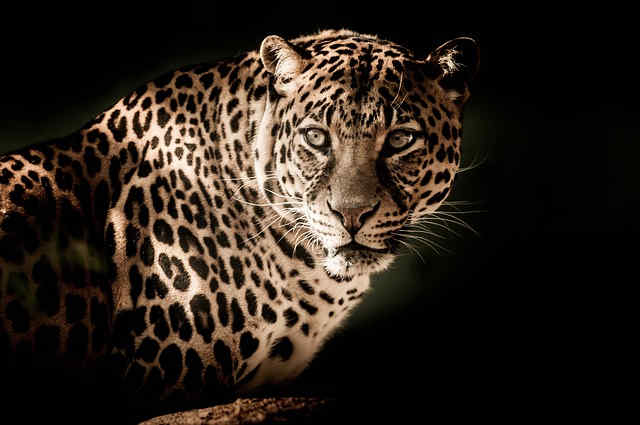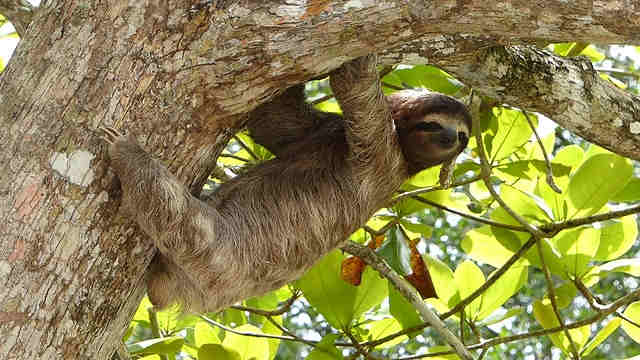A handful of indigenous South American tribes, stranded researchers, and illegal dealers of the latino black markets aren’t the only ones that love to enjoy the slow twitch muscles of the slowest mammal on earth — the sloth.
Wild animals that live around the spaces where sloths are found also find the dark meats on their bodies interesting, although, not necessarily their intestines since they’re constantly filled up to capacity with fibrous feaces!
Keep reading discover the fauna of the Amazonia that are heartless enough to make a meal out of a cute sloth.
What eats sloths?
Felid species and harpy eagles eat sloths although the latter is widely regarded as their main predator.
Harpy eagles combine their perfectly developed vision alongside their huge and deadly talons to monitor and snatch up their victims, respectively.
Felid species on the other hand mostly pounce on sloths that are at or near the forest floor, although most of them are known to be terrific climbers too and can easily climb up the distance to retrieve a sloth.
Below is a brief discussion on some of the well known predators of sloths.
The sloth predators
1) Harpy eagle
Harpy eagles are the main predators of sloths. They are the most powerful birds of prey that inhabit the canopy of the Neotropical rainforests.
Their name comes from the ancient mythical creatures, the harpies, which are known for their cruel and destructive nature and are depicted as half vulture, half human in mythological literatures.
As a top predator in the neotropics, harpy eagles feed mainly on arboreal mammals such as monkeys, sloths and porcupines. One study showed that juvenile and subadult sloths accounted for two-thirds of the entire body mass consumed at five harpy eagle nests in Parintins, Amazonas state, Brazil. Only 37% of the body mass found at a nest in Guyana were found to be of arboreal monkeys (Izor, 1985).
On a range, male harpy eagles typically weigh between 4.4 to 4.8 kg, while the females weigh between 7.35 to 8.3 kg — about double the size of their male counterparts.
With these weight and given the strength behind that body, harpy eagles are comfortably able to lift medium-sized mammals like sloths, monkeys and baby deers.
Often, females are the ones that hunt the larger sized mammals while the much smaller and agile males prey on juveniles and and tiny year olds, usually nothing more than 3 kg in weight.
As support for this skillful aerial lifting, harpy eagles have an impressive eye sight and excellent sense of hearing they use for pinpointing their prey.
They are capable of espying on objects as small as a dime from about 200 meters away. They have extremely powerful legs and long, sharp talons designed for stabbing, snatching and firmly gripping on their victims.
For a much larger species of sloths like the two fingered variety, particularly the adult males, harpy eagles prefer to drop them from the safety of the canopy where they reside to the forest floors, in order to inflict serious wounds on them or possibly cause them to perish (highly unlikely).
Then, they feast on their heads almost immediately before taking the remains back to their nests.
Harpy eagles are able to sucessfully kill sloths most of the time because of their strictly sedentary or unsocial lifestyle.
Arboreal mammals like monkeys which mostly live in groups are able to deter away the raptor and prevent it from carrying away any prey by keenly relying on their numbers as an advantage.
Harpy eagles can feed on their kill for several days without falling sick from the rotten carcass. This flexibility enables them to go a whole week or more without hunting down any new preys.
The predation of harpy eagles on sloths and other arboral folivires is thought to have a positive impact on forest regeneration and balance.
By preying on animals that mostly consume leaves and grasses, they help to limit the impact of these herbivores on primary prodcution, which in effect, helps to keep the forests evergreen.
Harpy eagles can grow as tall as one meter and their wingspan can be longer that the height of an average human adult.
Here is a video of a harpy eagle’s unsuccessfully attempt on a sloth
2) Felids of the amazonia

Felids (of the amazonia) are basically wild or big cats that live in and around the sloths habitat. They include the likes of jaguar, Jaguarundi, puma and ocelot.
They too prey on sloths but mostly attack ones that are descending from their canopy or have descended from their canopy. They have a wide variety of food resources to choose from the ground which is why their interest for sloths and other arboreal mammals are hugely suppressed.
Felids are top predators and they use their ferocious energy along with their vicious teeth and claws to tear up their preys into bits.
Here is a video of a successful puma attempt on a sloth
https://m.youtube.com/watch?v=mR5MkYSNR9Y
3) Other predators
Tayra, large owls, and several snake species have also been observed to prey on sloths in the wild; particularly (for the snakes and Tayras) when they descend to the forest floors to defecate or change environment.
Quick list of the sloth’s predators
- Harpy eagle
- Ocelot
- Jaguar
- Puma
- Tayra
- Boa
- Python
- Owl
- Hawk
- Jaguarundi
The sloth’s adaptations to predation
Sloths are arboreal folivores, meaning that they live in the crown of trees and are literally embedded in and surrounded by their food at all times and in all directions: they eat tropical leaves and shoots.
High up in the canopies, they survive completely with a short-sighted vision and a rudimentary sense of hearing.
They rely mostly on their sense of smell and spatial memory to actively penetrate their broader environment for food and predatory shelter.
Nearly every aspect of a sloth’s arboreal lifestyle is an adaptation to avoid detection by land predators and aerial raptors.
By having the slowest metabolic rate among all living mammals, sloths have very little energy circulating within their system at any given time.
This means that in order to conserve the little energy generated within their body, locomotion must be strictly limited to periods when it’s “only necessary” and has to be in a deliberate and unhurried fashion.
As a result, whenever sloths aren’t actively browsing through leaves and selecting from younger branches to feed from, they are found nestled in the fork of tree branches with their heads deeply buried within their chests, or hanging upside down from tree branches by means of their long sturdy claws; externally inactive or deeply asleep.
(Sunquist and montgomery, 1973) observed that wild sloths move an average of seven to ten hours of the twenty-four hours in a day. Such manner of lifestyle effectively conceals their existence and recede their activities from predators.
A cryptic body hair
Sloths have an outer grooved coating of longer thick hair with a dense undercoat of short downy fur.
Several myriad organisms like arthropods and nematodes take up residence in these furs, but not a single one of them (with an exception of the living tribe of algae) confer any sort of anti-predatory benefits.
The living tribe of green algae produce a greenish-tinge on their pelages and cause them to resemble clump of leaves or algae sheltered tree-trunks.
For all sloth species, lethargy and algae camouflage are their main survival strategy and not their biting or clawing techniques.
By incorporating these two tactics and residing high up in the tree canopies, they become notoriously difficult to spot with the naked eyes let alone be suffocated under any savage claws.
Indeed, it took researchers many years to figure out that close to 700 sloths may inhabit one square kilometer of the tropical rainforest (Sunquist, 1986).
Even (Montgomery et al. 1973) were only visually able to locate sloths in their field study five percent of the time, despite the fact that the animals wore radio-collars.
Rudimentary defense
When all the crypticness and grave silence fails to prevent a sloths from going unnoticed by a predator, the next tactic is to resort back to a defensive repertoire packed with meager defensive skills and mechanism: weak clawing, hissing, puffing up hoodwink and biting.
Sloths have 4 inch claws that are long and strongly built. These can cause serious scratches on the body of their aggressors when they swipe at them on the right spot.
Additionally, sloths also have a pointy set of conical teeth that can jab through tissues and leave holes that are large enough to be seen through.
Surprisingly, sloths can run faster than the speed of light when its time to bite or claw at an individual [1].
Despite the fact that sloths claw and bite aggressively when they feel harassed, the miserable strength buried within those slow twitched muscles are no match for the ferocious energy of their hunters.
The perks of extreme adaptation
Such savage form of adaptations in sloths surely comes with a price tag. A heavy one for that matter.
As accommodating as it is in the forest canopies, sloths are virtually helpless on the forest grounds.
Their slow metabolic rate supplies little energy that indirectly confers them invisibility, but also results in an overall reduction and rearrangement of their entire muscle mass.
Muscles require a bulk of energy to maintain and so sloths have evolved an energy-saving tactic to get rid of many redundant muscles and rearrange the remaining ones in such a manner that only befits their lethargic and arboreal lifestyle. (They spend most of their lifetime in the canopy of tropical trees).
Sloths have 30 to 25 percent less muscle mass compared to mammals of similar size. Their bodies are almost completely dominated by retractor or pulling muscles with very fewer extensor or pushing muscles.
Their joints also lack necessary supportive tissues and any core stability. This configuration enables them to easily suspend from tree branches whilst expending very little energy, but at the same time, it completely sacrifices their ability to support their own body weight on the ground.
On the forest floors, sloths drag their bodies by finding a hold with their foreclaws and pulling themselves forward using their strong retractor muscles.
In such conditions, and given their lethargic nature, sloths pitifully become they prey animals of even the smallest sized lizards and birds.
Despite being aware of this huge inescapable disadvantage, sloths stubbornly descend from the safety of the canopy to defecate at the forest floor once a week [2].
For whatever reason? Scientist are still trying to make a sense of it. But one thing is clear from a research conducted by Pauli and Peery in 2013, nearly two thirds of all sloth mortalities they observed in a field study happened as a result of depredation event when sloths were at or near the forest floors! [3]. Their predators are of course; harpy eagles, snakes, tayras, medium owls and felids.
More interesting sloth articles:
Obsessed with sloths? Check out our sloth category to learn more about them:
Reference
i) F. Helena Aguiar-Silva “Food Habits of the Harpy Eagle, a Top Predator from the Amazonian Rainforest Canopy,” Journal of Raptor Research, 48(1), 24-35, (1 March 2014). https://doi.org/10.3356/JRR-13-00017.1
Cite this Article ” (APA Format)
Bunu. M. (2020, March 26). Sloth Predators: What eats sloths?. Retrieved from http://emborawild.com/what-eats-sloths/

